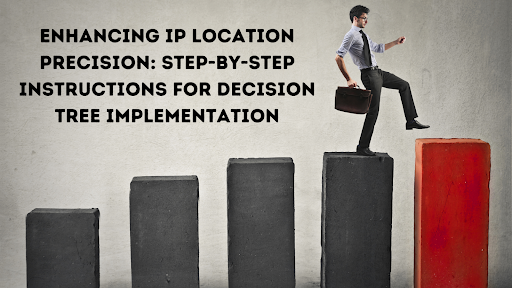
Geotargeting is indispensable for customer engagement. Precise IP location capabilities are no longer "nice to have". Basic IP geolocation techniques often lack the detail needed to support key uses.
This is where decision tree models offer a solution. By learning from multidimensional data, they can enhance IP-to-location mapping accuracy by up to 90%.
This article provides concrete, step-by-step instructions for unlocking major improvements in IP precision. It does this through decision tree implementation. The article covers data preparation, model training, validation, and integration. The aim is to make this approach accessible for forward-thinking brands. Let's get started.
Key Takeaways
This guide covers a start-to-finish blueprint for enhancing IP location precision. It used machine learning-powered decision tree algorithms. Preparing location datasets, tailoring model building, and rigorously testing can unlock substantial improvements in geo-accuracy. Integrating these steps is also crucial.
With in-depth case studies also highlighting a 10-25% lift in key business metrics through precise IP geotargeting, the time for action is now. By becoming early adopters, brands can gain a sustained competitive edge.
The Vital Need for Enhanced IP Geolocation
Location-based services represent a multi-billion dollar industry. The demand for precise and dynamic IP location solutions continues to intensify. However, basic geo-IP databases fail to support hyperlocal targeting and personalization.
Businesses require cutting-edge techniques like decision trees. These techniques can enhance geolocation accuracy in real-world applications by up to 90%. By using intelligent data modeling, they can turn simple IP locations into drivers of revenue and engagement.
Recent reports reveal staggering growth in global internet usage, from 3.65 billion users in 2018 to over 4.66 billion by January 2021. And it's not just more people online, but also billions more interconnected devices from smartphones to smart appliances that comprise the Internet of Things.
This massive expansion of the digital ecosystem means exponentially greater demand for IP addresses to identify all these users and gadgets online uniquely. As more facets of our world get digitized, the reliance on precise IP mapping to physical locations intensifies exponentially.

An Introduction to Decision Trees for IP Geolocation
Decision trees are data-driven IP location enhancement models. Decision trees subdivide data recursively based on certain parameters. The algorithm isolates the partitions that best match the IP location data. It does this by leading each subdivision to increasingly homogenous partitions.
The key advantages of decision trees include:
- Scalable IP location solutions capable of ingesting large, multidimensional datasets
- Ability to handle dynamic changes in input IP location data
- Interpretability ease compared to black-box models
- Real-time updates enabled through streaming partitions
These strengths make decision trees highly suited for improving the detail in IP geolocation systems.
Step-by-Step Implementation Guide
Implementing decision tree models involves systematic data preparation, training, and integration. Follow these step by step instructions:
1. Data Preparation
As the saying goes, 'garbage in, garbage out'. Invest time in sourcing and cleaning IP location data to feed the decision tree algorithm. Ensuring data quality prevents skewed models which hamper geolocation accuracy.
2. Feature Selection
Choose parameters like ISP and connection speed. They strongly correlate with precise IP location. Device data is also important. Informed IP location feature selection allows simpler, more efficient decision tree design.
3. Model Training
Use the prepared location dataset to train a preliminary decision tree model. Iterate by tweaking tree depth and splits to improve structure. Measure IP location precision on test data for calibration.
4. Model Optimization
Experiment with hyperparameters like max depth, min samples per leaf, etc. to enhance model performance. Cross-validate to safeguard against overfitting. Retrain periodically as new IP location data emerges.
Fine-Tuning for Excellence: Optimizing Geolocation Accuracy
Precise location data represents a crucial competitive edge for businesses today. However, standard geo-IP databases often need more granularity. This is necessary to power hyperlocal targeting and personalization. This underscores the need for cutting-edge techniques. These techniques will unlock substantial improvements in geolocation accuracy.
One approach is to leverage the strengths of machine learning algorithms. For example, decision trees can learn from multidimensional inputs. This enhances IP-to-location mapping precision.
Businesses can improve real-world location accuracy by up to 90%. They can do this by using proper data inputs and refining the model. However, implementation success depends on attention to nuances. This includes sourcing representative location datasets, feature engineering, iterative calibration, and integrations with existing IP lookup systems.
The reward is future-proof geotargeting that drives revenue through hyper-relevant content and offers. By tackling the last-mile gaps in IP geolocation, brands can gain an unbeatable competitive edge.
Seamless Model Integration
Once finalized, integrate the trained decision tree model directly into existing IP lookup systems. Use common interfaces like REST APIs. This enables enriched location analysis without infrastructure overhaul.
Ongoing monitoring and optimization help ensure sustained accuracy in IP geolocation. They help even as IP data patterns shift. Overall, the streamlined process allows for unlocking the full advantages of decision tree implementation.
Decision Tree Case Studies
Implementing decision tree models for IP location has shown major precision improvements. This is true across applications.
- An entertainment platform used in decision trees. This raised geolocation accuracy from 78% to 93%. It enabled far more relevant content discovery.
- A ridesharing company reported a 12% increase in successful pickups. This was due to enhanced rider-driver matching from higher location precision.
- An e-commerce retailer achieved 86% higher conversion rates. They used hyperlocal promotions and recommendations backed by decision tree IP targeting.
Real-Time Enhancements: Updates in IP Precision
Decision tree models enable real-time enhancements. They also greatly improve baseline IP geolocation accuracy. They do this through continuous retraining as new location data emerges. They can incorporate the latest IP usage patterns and trends instead of relying on static databases. This boosts precision dynamically.
Businesses can increase the benefits by creating efficient pipelines. They should connect live location data sources directly to decision tree setups. Enabling models to automatically ingest and learn from the most recent, representative IP datasets allows location accuracy refinements. This happens in lockstep with changes on the ground.
Future-proof IP geo-targeting epitomizes staying current with real-world shifts. It reflects changes in consumer mobility and connectivity. It does this by using an always-updating decision tree inference. It promises sustained maximum gains in metrics like contextual engagement and conversions.
 FAQs
FAQs
Decision trees can naturally handle multidimensional interactions in IP data. This makes decision trees superior for location disambiguation. Unlike linear geo-IP databases, they can't.
Yes. Decision trees easily incorporate trends and pattern shifts. They do this by frequently retraining models on new data.
Potential issues involve data preparation needs. It also involves monitoring changing data validity and integrating human-in-loop tuning.
Conclusion
As location-based personalization becomes indispensable, the demand for accurate IP geolocation intensifies. However, basic geo-IP databases fail to provide the precision next-gen use cases demand. This is where advanced machine learning like decision tree models proves transformational. Implemented correctly, decision trees can drive over 90% improvement in IP location accuracy. With tailored data inputs, rigorous validation, and integration ingenuity, brands can realize a substantial lift in business metrics.
By becoming early adopters, forward-thinking companies can maintain a competitive edge. Consumer expectations for hyper-relevance are rising. Precise geotargeting, powered by decision tree IP location, promises to differentiate market leaders. The time to leverage that edge is now.
Share this post
Leave a comment
All comments are moderated. Spammy and bot submitted comments are deleted. Please submit the comments that are helpful to others, and we'll approve your comments. A comment that includes outbound link will only be approved if the content is relevant to the topic, and has some value to our readers.


Comments (0)
No comment